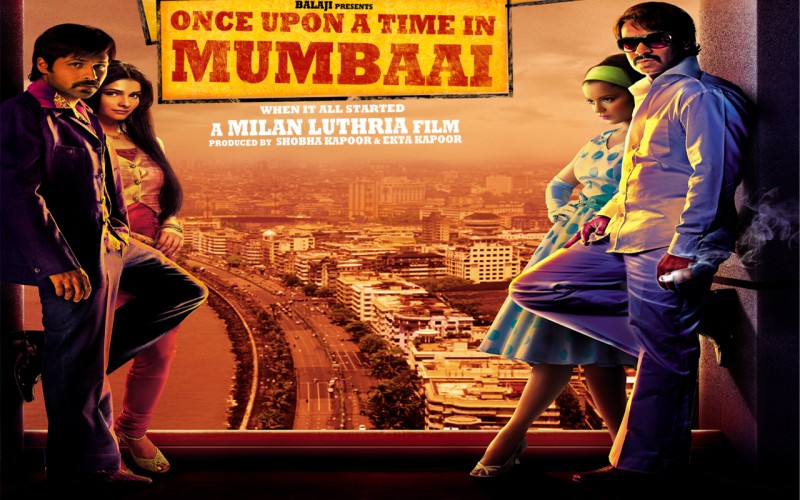
Few movies in the history of Indian cinema have been able to accurately capture the essence of Mumbai's underworld as "Once Upon a Time in Mumbaai." This period crime drama, which Milan Luthria directed and was released in 2010, was well-received by critics as well as audiences, and it was a financial success. With a remarkable Rs. 6 crore opening and Rs. 22 crore in weekend earnings, it set off on an amazing journey that solidified its reputation as a cult classic.
The 1970s Mumbai underworld was brought to life for viewers of "Once Upon a Time in Mumbaai" in a gloomy and fascinating manner. The story of the movie focused on the ascent of two infamous gangsters, Sultan Mirza (Ajay Devgn) and Shoaib Khan (Emraan Hashmi), who fought for dominance of the city's criminal underworld. The movie was a heady blend of crime, romance, and drama, with Kangana Ranaut and Prachi Desai playing pivotal roles.
The outstanding cast played a key role in the movie's success. Sultan Mirza, a fictional character created by Ajay Devgn and based on the actual gangster Haji Mastan, became unquestionably famous thanks to his performance. The contrast of a gangster with a good heart was brought to life by his nuanced performance. As Sultan's aspirational protege Shoaib Khan, Emraan Hashmi, dubbed the "Serial Kisser" of Bollywood, deviated from his usual roles and gave an engaging performance.
By playing their respective parts, Kangana Ranaut and Prachi Desai gave the story depth. As Sultan's potential love interest, Rehana, Kangana demonstrated her acting range in the role. The innocence of Yasmin, Shoaib's love interest, was gracefully and charmingly portrayed by Prachi Desai in her second Bollywood outing.
The success of the movie was largely attributable to Milan Luthria's direction. He skillfully juggled the movie's various components, from the tense action scenes to the characters' conflicted emotions. The film had an authentic and immersive feel thanks to Luthria's meticulous attention to detail and his ability to capture the atmosphere of Mumbai in the 1970s.
The story of "Once Upon a Time in Mumbaai" was deftly woven, delving into the intricate relationships between loyalty, power, and love in the Mumbai underworld. The story of two gangsters engaged in a struggle for dominance in the gripping movie featured two characters with very different moral codes. Shoaib Khan, who was motivated by ambition and ruthlessness, was the antithesis of Sultan Mirza, who had morals and a sense of justice akin to Robin Hood.
Rajat Arora, who also wrote the dialogue for the movie, gave the characters more nuance and created catchphrases that Bollywood fans will remember. Real power resides in the heart, as stated in the movie's catchphrases "Asli power dil mein hoti hai" and "Raja ka beta Raja nahi banega, yeh toh ek raja hi jaan se maarta hai." These lines struck a chord with the audience and helped the movie maintain its popularity over time.
Without mentioning its stirring score, "Once Upon a Time in Mumbaai" cannot be discussed. The music of the movie, which was written by Pritam, became essential to its story. Songs like "Pee Loon," "Tum Jo Aaye," and "Ajnabi" not only enhanced the storytelling but also topped the music charts, making them classics that endure throughout time.
The box office success of "Once Upon a Time in Mumbaai" got off to a roaring start. An impressive feat for a production with such a small budget was the movie's first-day revenue of more than Rs 6 crore. This impressive opening performance gave the movie a good chance of connecting with viewers.
The movie's box office receipts increased over the weekend, earning a stunning Rs 22 crore. This incredible feat is a testament to the film's compelling plot, excellent performances, and captivating direction. Praise from others and favorable evaluations contributed to its growth.
In addition to being a financial success, "Once Upon a Time in Mumbaai" developed a cult following over time. Its status as a classic in Indian cinema has been cemented by its compelling story, enduring cast of characters, and portrayal of Mumbai's underworld during a turbulent time.
The legacy of the movie goes beyond the screen. It sparked discussions about the hazy boundaries between good and evil, morality and ambition, and the allure of power that is impossible to resist. It also demonstrated the adaptability of Bollywood actors, especially Emraan Hashmi, who changed from his image as a romantic hero to that of a nuanced anti-hero.
"Once Upon a Time in Mumbaai" is a prime example of the wonder that can occur when a strong script is combined with outstanding acting talent from both in front of and behind the camera. Its box office success, which featured a strong debut and a strong weekend haul, signaled the start of an incredible journey. Bollywood's storytelling prowess and capacity to explore complex characters and narratives are frequently discussed in relation to the movie due to its enduring appeal and cult status in Indian cinema.
"Once Upon a Time in Mumbaai" continues to be a timeless classic and a cinematic gem that shines brightly in the annals of Indian cinema as the Mumbai underworld saga continues to captivate audiences.
Suman Kalyanpur's Magical Melodies: A Journey in Music